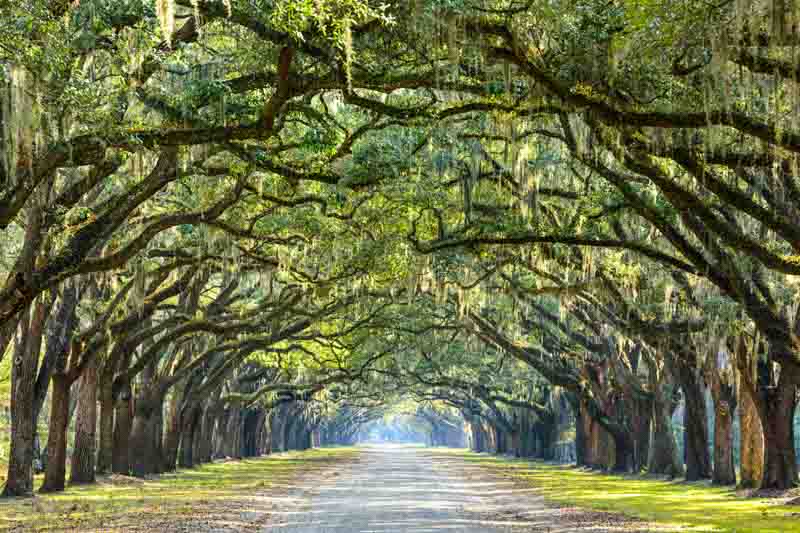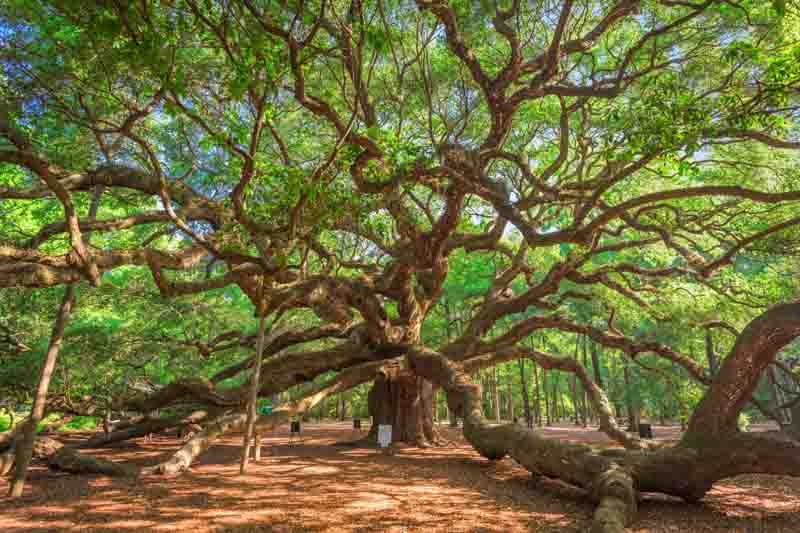Live Oak, Southern Live Oak, Virginia Live Oak, Bay Live Oak, Plateau Oak, Scrub Oak
Long-lived and majestic, Quercus virginiana (Live Oak) is a large evergreen tree adorned with a wide-spreading, rounded crown, its lower limbs stretching great distances from the trunk. Symbol of the South and its old plantations, its heavy branches are often graced with Spanish moss.
The Live Oak is a majestic and iconic tree known for its robust structure, sprawling branches, and longevity. Its massive limbs, which can extend outward as much as they grow upward, give it a distinctive, wide-spreading canopy.
Native: Native to the southeastern United States and Mexico, Live Oak trees are quintessential to Southern landscapes, particularly in coastal areas. The live oak belongs to the white oak group,
Plant Type and Habit: It is a large, evergreen tree known for its broad, spreading form and sturdy trunk. Live Oak trees are known for their longevity, often living over 200 years, with famous examples like South Carolina’s Middleton Oak and Angel Oak, the latter being estimated to be 400 to 500 years old.
Size: Typically grows to 40-80 feet tall (12-24 meters), with a spread often greater than its height, sometimes reaching up to 60-100 feet (18-30 m).
Flowers: The Live Oak tree produces small, inconspicuous greenish-yellow flowers in spring. Male flowers are on catkins, while female flowers are solitary.
Fruits: It produces oval acorns, a crucial food source for small mammals and birds. They are small to medium-sized, enclosed in a cup-like structure.
Foliage: The leaves of this evergreen oak are smooth-edged, dark green, leathery, and glossy, with a paler underside, remaining on the tree almost all year.
Bark: With age, the bark of the sinuously curved trunk and branches becomes very dark and cross-checked, providing significant textural interest.

Avenue of live oaks at historic Wormsloe Plantation, Savannah, Georgia, USA.
Uses: Widely used for landscaping due to its grand stature and shade-providing canopy. It is a magnificent and picturesque shade tree for lawns and large areas. Its wood is valuable for timber and furniture.
Hardiness: Live Oak is hardy and suited for USDA zones 8-11. Tolerant of a variety of conditions but prefers warmer climates.
Wildlife: Provides habitat and food for a variety of wildlife, including birds and mammals. The acorns are especially important for deer, squirrels, and other mammals. The Live Oak tree is an important host plant for several butterfly species, such as the Red-spotted Purple (Limenitis arthemis), the Horace’s Duskywing (Erynnis horatius), and the Juvenal’s Duskywing (Erynnis juvenalis).
Toxicity: The leaves, bark, and acorns of the Live Oak have high tannin levels, which can be harmful to horses if eaten in large amounts. Young leaves, flower buds, and unripe green acorns are the most toxic parts. While many horses avoid these parts and remain unaffected, some may consume large quantities of green acorns and become ill.
Deer and Rabbit: Generally resistant to browsing by deer and rabbits due to its size and the texture of its foliage.
Drought Tolerance: Exhibits good drought tolerance once established. Young trees may require supplemental watering.
Salt Tolerance: Live Oak trees exhibit significant salt tolerance, making them well-suited for coastal environments and landscapes exposed to sea spray or saline soils.
Wind Tolerance: Live Oaks are highly wind-resistant, thanks to their strong wood and deep root systems. This makes them ideal for areas prone to strong winds or storms.
Invasiveness: Not considered invasive. Live Oak trees grow slowly and are typically well-behaved in their native range.
Benefits: Besides ecological benefits, Live Oaks increase property values and contribute to the overall beauty of landscapes. They also play a role in carbon sequestration.

Angel Oak Tree, Charleston, South Carolina, USA. Estimated to be 400–500 years old.
Light: Prefers full sun but can tolerate partial shade. Optimal growth and form are achieved in open, sunny locations.
Soil: Adaptable to a wide range of soil types, from sandy to clay. Prefers well-drained, slightly acidic to neutral soil.
Water: Requires regular watering during the first few years to establish a deep root system. The Live Oak tree will survive well on both dry sites and in wet areas, effectively handling short-duration flooding if water is moving and drainage is good. Once established, it has good drought tolerance.
Fertilizer: Young trees benefit from a balanced, slow-release fertilizer in spring. Mature trees typically do not require supplemental feeding.
Pruning: Prune young trees to establish a strong structure. Remove dead or crossing branches and maintain clearance as needed.
Propagation: Commonly propagated by acorns. Best sown immediately after collection in the fall. Grow your own oak tree: a step-by-step guide to planting acorns.
Pests/Diseases: Live Oaks are generally robust trees but can be susceptible to certain pests and diseases. Galls might damage the foliage but generally don’t impact the tree’s overall health. However, issues like root rot and oak wilt can pose significant problems. Learn more about the pests and diseases of oak trees.
| Hardiness |
8 - 11 |
|---|---|
| Climate Zones | 4, 5, 6, 7, 8, 9, 10, 11, 12, 13, 14, 15, 16, 17, 18, 19, 20, 21, 22, 23, 24 |
| Plant Type | Trees |
| Plant Family | Fagaceae |
| Genus | Quercus |
| Common names | Live Oak, Oak, Southern Live Oak |
| Exposure | Full Sun |
| Season of Interest |
Spring (Early, Mid, Late) Summer (Early, Mid, Late) Fall Winter |
| Height |
40' - 80' (12.2m - 24.4m) |
| Spread |
60' - 100' (18.3m - 30.5m) |
| Maintenance | Low |
| Water Needs | Low, Average |
| Soil Type | Clay, Loam, Sand |
| Soil pH | Acid, Alkaline, Neutral |
| Soil Drainage | Moist but Well-Drained, Well-Drained |
| Characteristics | Showy, Evergreen |
| Native Plants | United States, Southeast, Louisiana, Mississippi, North Carolina, South Carolina, Virginia, Alabama, Florida, Georgia, Southwest, Texas |
| Tolerance | Drought, Salt, Dry Soil |
| Garden Styles | Prairie and Meadow |
| Hardiness |
8 - 11 |
|---|---|
| Climate Zones | 4, 5, 6, 7, 8, 9, 10, 11, 12, 13, 14, 15, 16, 17, 18, 19, 20, 21, 22, 23, 24 |
| Plant Type | Trees |
| Plant Family | Fagaceae |
| Genus | Quercus |
| Common names | Live Oak, Oak, Southern Live Oak |
| Exposure | Full Sun |
| Season of Interest |
Spring (Early, Mid, Late) Summer (Early, Mid, Late) Fall Winter |
| Height |
40' - 80' (12.2m - 24.4m) |
| Spread |
60' - 100' (18.3m - 30.5m) |
| Maintenance | Low |
| Water Needs | Low, Average |
| Soil Type | Clay, Loam, Sand |
| Soil pH | Acid, Alkaline, Neutral |
| Soil Drainage | Moist but Well-Drained, Well-Drained |
| Characteristics | Showy, Evergreen |
| Native Plants | United States, Southeast, Louisiana, Mississippi, North Carolina, South Carolina, Virginia, Alabama, Florida, Georgia, Southwest, Texas |
| Tolerance | Drought, Salt, Dry Soil |
| Garden Styles | Prairie and Meadow |
How many Quercus virginiana (Live Oak) do I need for my garden?
| Plant | Quantity | |
|---|---|---|
| Quercus virginiana (Live Oak) | N/A | Buy Plants |
Create a membership account to save your garden designs and to view them on any device.
Becoming a contributing member of Gardenia is easy and can be done in just a few minutes. If you provide us with your name, email address and the payment of a modest $25 annual membership fee, you will become a full member, enabling you to design and save up to 25 of your garden design ideas.
Join now and start creating your dream garden!
Create a membership account to save your garden designs and to view them on any device.
Becoming a contributing member of Gardenia is easy and can be done in just a few minutes. If you provide us with your name, email address and the payment of a modest $25 annual membership fee, you will become a full member, enabling you to design and save up to 25 of your garden design ideas.
Join now and start creating your dream garden!